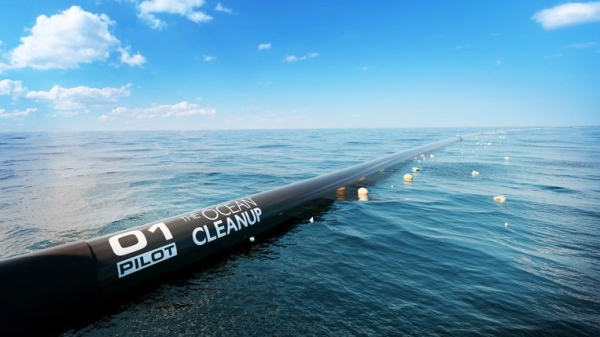For decades, a solution to the problem of marine plastic pollution has seemed out of reach. Fortunately, Boyan Slat, an entrepreneur from the Netherlands, has invented a floating device that removes garbage from the surface of the ocean.
Slat was 16 years old when he scuba dived in the Mediterranean Sea and saw more plastic bags than fish, an observation which prompted his novel invention.
In 2013, Slat started The Ocean Cleanup, an organization dedicated to developing new environmental technologies such as Slat’s floating device. Since then, the Ocean Cleanup has received nearly USD$35 million in funding from major sponsors including Marc Benioff, the chief executive of Salesforce.com, and Peter Thiel, the co-founder of PayPal. The organization now employs more than 70 engineers, researchers, scientists, and computational modellers to meet its ambitious goal: To clean up 90 per cent of the Great Pacific Garbage Patch by 2040.
Slat’s floating device consists of a 600 metre long boom, a floating tube used to contain or divert material such as trash, aquatic plants, and oil to collection areas. Wind and waves push the floating device, trapping the floating plastic in its three-metre deep skirt.
The device was officially launched on Sept. 8 from San Francisco and is headed for the Great Pacific Garbage Patch between California and Hawaii. A support vessel will remove the collected plastic, and bring it back to land to recycle the waste into consumer products.
The launch of the device has brought widespread media attention to the devastating impact of plastic pollution on marine ecosystems.
“We are just starting to learn what effects plastic pollution might have on marine life,” Eric Galbraith, an Earth Systems professor at Universitat Autònoma de Barcelona, wrote in an email to The McGill Tribune. “Large pieces of plastic definitely interfere with the feeding of large animals [….] From seabirds to turtles to whales, large animals have been found accidentally eating plastics to the point where it can block their digestion, causing death. We don’t really know just how bad small plastic particles might be, but there are signs that they can affect the feeding of zooplankton (very small animals) and can potentially harbour toxins.”
Although the floating device seems promising, it has its limitations. The device’s skirt is designed to allow aquatic organisms to swim underneath, but some scientists are concerned that marine life will still get trapped. Others believe that this device is a good start to tackling ocean pollution, but not enough to solve the problem.
“When you look at the infrastructure they propose, it drifts at the surface and has a giant net, but they mention it only goes three metres below the surface of the ocean,” Carolina Dufour, an assistant professor in McGill’s Department of Atmospheric and Oceanic Sciences, said. “We know that plastic can be found at any depth, including at the bottom. So a major concern would be, what do we do with the plastic below three metres deep?”
Although Dufour expressed support for any technology that can help clean up the oceans, she stressed the importance of taking individual and collective action to stop plastic pollution in the first place. She cautioned against people becoming complacent in thinking technological advancements will solve every environmental problem.
Slat has responded to criticisms with data from The Ocean Cleanup’s voluntary Environmental Impact Assessment, which says the impact on marine life will be minimal, while acknowledging that any new technology will experience setbacks and subsequent improvements.
While this invention is a step forward for ocean cleanup efforts, stopping plastic pollution at its source remains a difficult task that requires major changes to reliance on single-use, disposable plastics. Nonetheless, inventors such as Slat are making waves in the world of ocean conservation and inspiring others to take action on pressing environmental issues.






